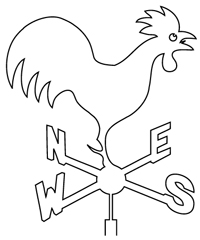![]()
PEOPLE HAVE ALWAYS been fascinated by – and in awe of – the elements, and with good reason. Long ago, before food grown in one country could be flown right across the world to another country, populations were much more dependent on what they produced locally – and hence on the weather that could spell success or ruin for a crop. Way back then, before modern meteorology and hi-tech forecasting, it must have seemed to many that they were at the mercy of capricious forces they did not understand.
Wind vanes are one of the first forms of forecasting equipment – going back to the era BC, in fact, and ancient Babylon, Egypt, China and Greece. The most celebrated of these old-world vanes sat at the top of the Tower of the Winds, a structure 12 metres (approx. 40 feet) high that was built by the astronomer Andonikos in Athens in about 50 BC. Depictions of the gods associated with each of the eight wind directions were carved into its side, and a bronze Triton holding a rod stood on top of the tower. When the wind blew, he would spin on his axis and point his rod into the wind. Later, wind vanes were a popular addition to the European churches of the Middle Ages.

In the fourth century BC, one of the greatest of all Greek philosophers, Aristotle – who was also tutor to Alexander the Great – produced the first serious study of the atmosphere. In this, he presented his theories on a wide variety of natural phenomena, from rainbows to snow. He entitled his work Meteorologica, after the Greek word ‘meteorol’, meaning an occurrence in the sky. From this we get both the words ‘meteor’ and ‘meteorology’ – the study of heavenly happenings.
A NUMBERS GAME
According to the Italian explorer Marco Polo (c.1254–c.1324), the great Mongol conqueror and emperor Kublai Khan (1215–94) kept around 5,000 court astrologers. Among their duties was forecasting the weather – and getting it right or wrong was a matter of life or death. But with so many other astrologers on hand, there was always another to take the place of the one who had ‘retired early’.
It isn’t particularly scientific, but you can observe the behaviour of your hair for an indication of how wet the air is. Like paper, hair shrinks when it is dry and stretches when it is moist, increasing by up to 2.5 per cent in length. This effect did not go unnoticed centuries ago and became the basis of a number of methods for recording humidity:
• The German Nicholas of Cusa (c.1401–64) invented a method for measuring humidity by checking the amount of moisture absorbed by wool.
• Others constructed hygrometers (humidity-recording devices) using, among other materials, human hair, ox’s intestine, rat’s bladder, strings and wild oats – all of which responded to a change in the moisture content of the air.
Renaissance Italians were ahead of the game when it came to early meteorological inventions:
• In about 1450, the Italian architect Leon Battista Alberti (1404–72) invented the first anemometer, a device for measuring windspeed.
• In about 1592, Galileo Galilei (1564–1642) invented an early thermometer.
• In 1643, Evangelista Torricelli (1608–47) – who was a man, not a woman as the name suggests – invented the mercury barometer for measuring atmospheric pressure.
Uneducated and without either the resources or leisure time to perform scientific experiments, ordinary people once relied on careful observation of nature to predict the weather, and a whole body of weather lore developed. Here are just a few examples…
It will be rainy and stormy if:
• flowers close up.
• the cows are lying down.
• there’s a ring of cloud around the moon.
• the swallows fly low (if they are flying high, the winds are light).
It will turn into a fine day if:
• it rains before seven.
• it’s foggy in the morning.
Winter will be severe if:
• squirrels store large quantities of nuts.
• squirrels have bushy tails.
• there are lots of berries on the trees.
• ant hills are high in July.
• hornets build their nests high.
• November is warm (obviously this applies only to the Northern Hemisphere where this is a winter month).
A ROSY GLOW
Not all folklore about the weather is old wives’ tales. The well-known saying ‘Red sky at night, shepherd’s delight; red sky in the morning, shepherd’s warning’ (or the American version, in which ‘shepherd’ is ‘sailor’) may have some foundation in fact. A red sunset sky is usually caused by reflections from minuscule dust particles trapped high in the atmosphere by conditions that occur before fine weather.